(完整版)四年级英语小学英语语法及习题.doc
- 格式:doc
- 大小:136.01 KB
- 文档页数:7
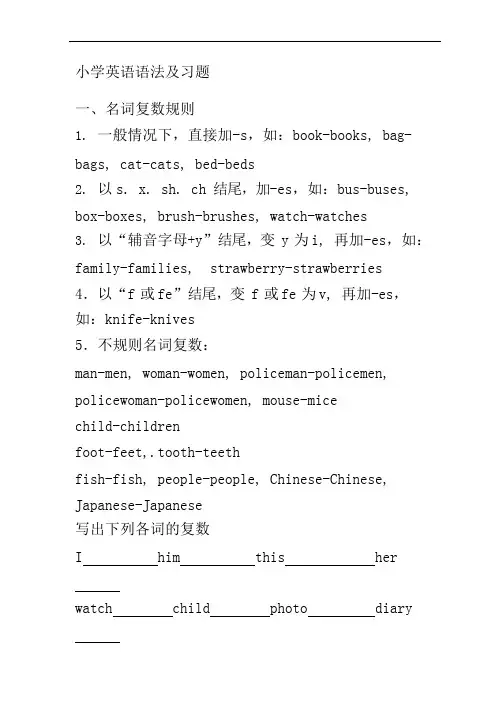
小学英语语法及习题一、名词复数规则1.一般情况下,直接加-s,如:book-books, bag- bags, cat-cats, bed-beds2.以s. x. sh. ch 结尾,加-es,如:bus-buses, box-boxes, brush-brushes, watch-watches3.以“辅音字母+y”结尾,变 y 为i, 再加-es,如:family-families, strawberry-strawberries4.以“f或fe”结尾,变 f 或fe 为v, 再加-es,如:knife-knives5.不规则名词复数:man-men, woman-women, policeman-policemen, policewoman-policewomen, mouse-micechild-childrenfoot-feet,.tooth-teethfish-fish, people-people, Chinese-Chinese, Japanese-Japanese写出下列各词的复数I him this her watch child photo diaryday foot book dresstooth sheep box strawberry thief yo-yo peach sandwichman woman paperjuicewater milk ricetea二、一般现在时一般现在时基本用法介绍【No. 1】一般现在时的功能1.表示事物或人物的特征、状态。
如:The sky is blue.天空是蓝色的。
2.表示经常性或习惯性的动作。
如:I get up at six every day.我每天六点起床。
3.表示客观现实。
如:The earth goes around the sun.地球绕着太阳转。
一般现在时的构成1.be 动词:主语+be(am,is,are)+其它。
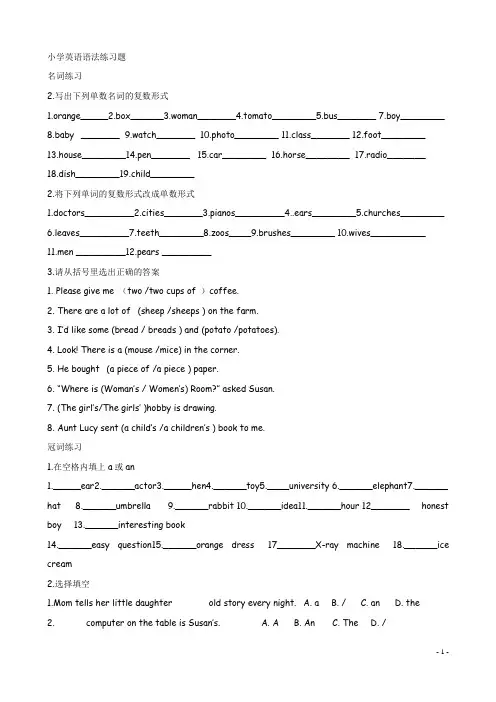
小学英语语法练习题名词练习2.写出下列单数名词的复数形式1.orange_____2.box______3.woman_______4.tomato________5.bus_______ 7.boy________ 8.baby _______ 9.watch_______ 10.photo________ 11.class_______ 12.foot________ 13.house________14.pen_______ 15.car________ 16.horse________ 17.radio_______ 18.dish________19.child________2.将下列单词的复数形式改成单数形式1.doctors_________2.cities_______3.pianos_________4..ears________5.churches________6.leaves_________7.teeth________8.zoos____9.brushes________ 10.wives__________ 11.men _________12.pears _________3.请从括号里选出正确的答案1. Please give me (two /two cups of )coffee.2. There are a lot of (sheep /sheeps ) on the farm.3. I’d like some (bread / breads ) and (potato /potatoes).4. Look! There is a (mouse /mice) in the corner.5. He bought (a piece of /a piece ) paper.6. “Where is (Woman’s / Women’s) Room?” asked Susan.7. (The girl’s/The girls’ )hobby is drawing.8. Aunt Lucy sent (a child’s /a children’s ) book to me.冠词练习1.在空格内填上a或an1._____ear2.______actor3._____hen4.______toy5.____university6.______elephant7.______ hat8.______umbrella9.______rabbit 10.______idea11.______hour 12_______ honest boy 13.______interesting book14.______easy question15.______orange dress 17_______X-ray machine 18.______ice cream2.选择填空1.Mom tells her little daughter old story every night. A. a B. / C. an D. the2. computer on the table is Susan’s. A. A B. An C. The D. /3.There is map of the world on wall. map is mine.A. a, a, AB. a, the, TheC. the, the, TheD. the, the, A5. Spring comes after winter. A. /, / B.The, / C.The, the D.A, the6.I bought shoes yesterday. shoes are very beautiful.A. a, TheB. a pair of, TheC. the, TheD. a pair, The pair7.He was soldier in the Second World War. A. a B. an C. the D. /8.She can play and .A. the tennis, the guitarB. tennis, guitarC. the tennis, guitarD. tennis, the guitar9.I can see moon and clouds in the sky. A. the, a B. a, a C. the, / D. the, the11. Tian’anmen Square is in Beijing. A. /, / B. A, / C. The, / D. /, the12.—Can you tell me nearest bookshop?—Go straight and turn right at_______third crossing, and you will see it.A. the, aB. the, theC. a, theD. the, /5.根据中文,写出下列固定搭配的英文。
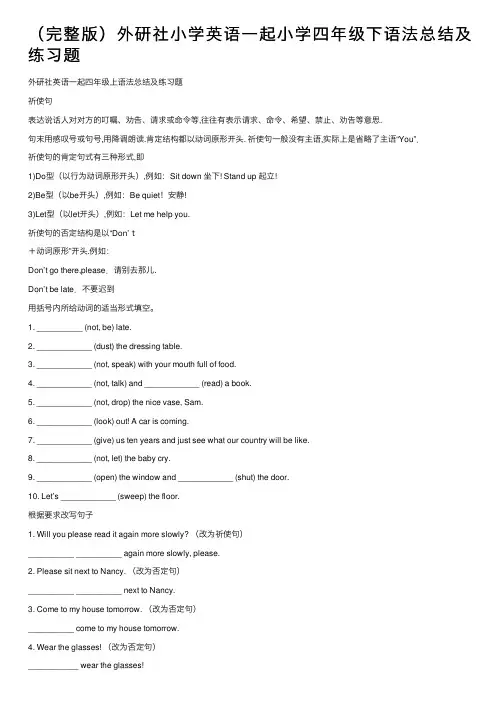
(完整版)外研社⼩学英语⼀起⼩学四年级下语法总结及练习题外研社英语⼀起四年级上语法总结及练习题祈使句表达说话⼈对对⽅的叮嘱、劝告、请求或命令等,往往有表⽰请求、命令、希望、禁⽌、劝告等意思.句末⽤感叹号或句号,⽤降调朗读.肯定结构都以动词原形开头. 祈使句⼀般没有主语,实际上是省略了主语“You”.祈使句的肯定句式有三种形式,即1)Do型(以⾏为动词原形开头),例如:Sit down 坐下! Stand up 起⽴!2)Be型(以be开头),例如:Be quiet!安静!3)Let型(以let开头),例如:Let me help you.祈使句的否定结构是以“Don’t+动词原形”开头.例如:Don’t go there,please.请别去那⼉.Don’t be late.不要迟到⽤括号内所给动词的适当形式填空。
1. __________ (not, be) late.2. ____________ (dust) the dressing table.3. ____________ (not, speak) with your mouth full of food.4. ____________ (not, talk) and ____________ (read) a book.5. ____________ (not, drop) the nice vase, Sam.6. ____________ (look) out! A car is coming.7. ____________ (give) us ten years and just see what our country will be like.8. ____________ (not, let) the baby cry.9. ____________ (open) the window and ____________ (shut) the door.10. Let’s ____________ (sweep) the floor.根据要求改写句⼦1. Will you please read it again more slowly? (改为祈使句)__________ __________ again more slowly, please.2. Please sit next to Nancy. (改为否定句)__________ __________ next to Nancy.3. Come to my house tomorrow. (改为否定句)__________ come to my house tomorrow.4. Wear the glasses! (改为否定句)___________ wear the glasses!5. Don’t wash your hands! (改成肯定句)___________ your hands!⼀般过去时时间状语:1.yesterday,morning(afternoon,evening)等2.由“last+⼀时间名词”构成的短语:last night,last year(winter,month,week)等3.由“时间段+ago”构成的短语:a moment ago,a short time ago,an hour ago等4.其它:just now等Was,were的⼀般过去时构成:肯定句式:主语+be(was,were)+其它.否定句式:主语+be(was,were)+not+其它.⼀般疑问句:Be(was,were)+主语+其它?肯定回答: Yes, 主语+ be(was,were)否定回答:No, 主语+be(was,were)+not.含有实义动词(⾏为动词)的⼀般过去时的主结构:构成:肯定句:主语+动词的过去时+其它。
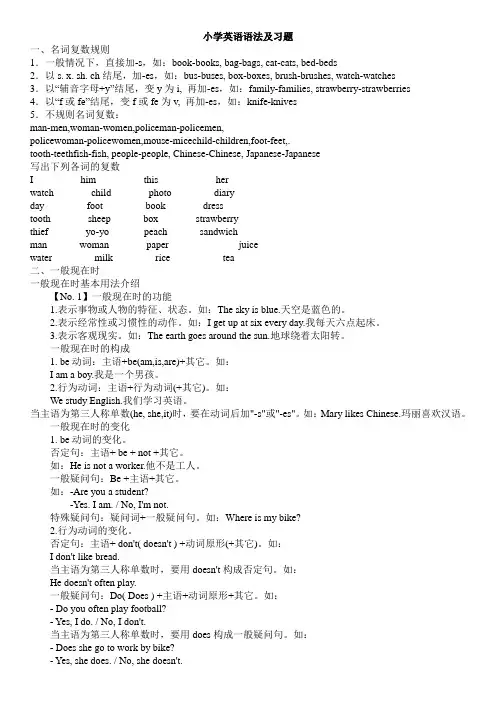
小学英语语法及习题一、名词复数规则1.一般情况下,直接加-s,如:book-books, bag-bags, cat-cats, bed-beds2.以s. x. sh. ch结尾,加-es,如:bus-buses, box-boxes, brush-brushes, watch-watches3.以“辅音字母+y”结尾,变y为i, 再加-es,如:family-families, strawberry-strawberries4.以“f或fe”结尾,变f或fe为v, 再加-es,如:knife-knives5.不规则名词复数:man-men,woman-women,policeman-policemen,policewoman-policewomen,mouse-micechild-children,foot-feet,.tooth-teethfish-fish, people-people, Chinese-Chinese, Japanese-Japanese写出下列各词的复数I _________him _________this ___________her ______watch _______child _______photo ________diary ______day________ foot________ book_______ dress ________tooth_______ sheep ______box_______ strawberry _____thief _______yo-yo ______ peach______ sandwich ______man______ woman_______ paper_______ juice___________water________ milk________ rice__________ tea__________二、一般现在时一般现在时基本用法介绍【No. 1】一般现在时的功能1.表示事物或人物的特征、状态。
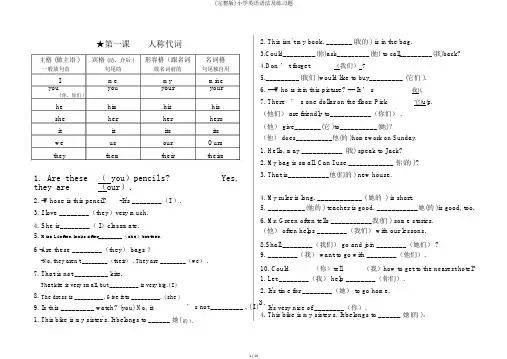
★第一课人称代词主格 (做主语 )宾格 (动、介后 )形容格(跟名词名词格一般放句首句尾的放名词前的句尾独自用I me my mine youyouyouryour ( 你,你们 )he him his his she her her hers it it its its weus our Ours theythemtheirtheirs1. Are these ( you )pencils? Yes,they are (our ).2. This isn`t my book. _______(我的 ) is in the bag.3.Could_________(你)ask_________(他) to call_________(我)back?4.Don ’ t forget (我们) ?5._________(我们 )would like to buy_________ (它们 ).6. ---Who is it in this picture? --- It ’ s 我)(.7. There ’ s one dollar on the floor. Pick它)u(p.(他们) are friendly to___________(你们) .(他) give_______(它 )to__________(她)?(他) does__________他(的 )homework on Sunday.1. Hello, may ___________ (我) speak to Jack?2. My bag is small. Can I use ____________ 你(的 )?3. That is___________他(们的 ) new house.2. -Whose is this pencil?-It's ________(I ).4. My ruler is long. ____________ ( 她的 ) is short.5. __________(他的 ) teacher is good. ___________她(的 )is good, too. 3. I love ________(they )very much.6. Mr. Green often tells ___________我(们 ) some stories. 4. She is________( I )classmate. (他) often helps ________(我们) with our lessons.5.Miss Li often looks after________(she )brother.6 -Are these ________(they ) bags ?8.Shall ________(我们) go and join ________(她们) ? 9. ________(我) want to go with ________(他们).-No, they aren't ________(their ) . They are ________(we ) .7. That is not _________ kite.10. Could(你)tell (我)how to get to the nearest hotel? 1. Let ________(我) help ________(你们). That kite is very small, but _________ is very big.( I )It's time for ________(她) to go home.8.2. The dress is _________. Give it to _________. ( she )9. Is this _________ watch? (you) No, it’ s not _________ . ( I )3.It's very nice of ________(你).1. This bike is my sister`s. It belongs to ______ 她( 4. This bike is my sister`s. It belongs to ______ 她(的 )。

小学英语语法及习题一、名词复数规则1.一般情况下,直接加-s,如:book-books, bag-bags, cat-cats, bed-beds2.以s. x. sh. ch结尾,加-es,如:bus-buses, box-boxes, brush-brushes, watch-watches3.以“辅音字母+y”结尾,变y为i, 再加-es,如:family-families, strawberry-strawberries4.以“f或fe”结尾,变f或fe为v, 再加-es,如:knife-knives5.不规则名词复数:man-men, woman-women, policeman-policemen, child-children,policewoman-policewomen, mouse-mice ,foot-feet, tooth-teeth,fish-fish, people-people, Chinese-Chinese, Japanese-Japanese写出下列各词的复数I _________him _________this ___________her ______sand_____ watch _______child _______photo ________diary ______day_____ foot________ book_______ dress ________tooth_______ man_____ sheep ______box_______ thief _______ peach______ wich ______ woman_______ paper_______ juice___________ water_______milk________ rice__________ tea__________ strawberry ________二、一般现在时(一)一般现在时基本用法介绍1、表示事物或人物的特征、状态。
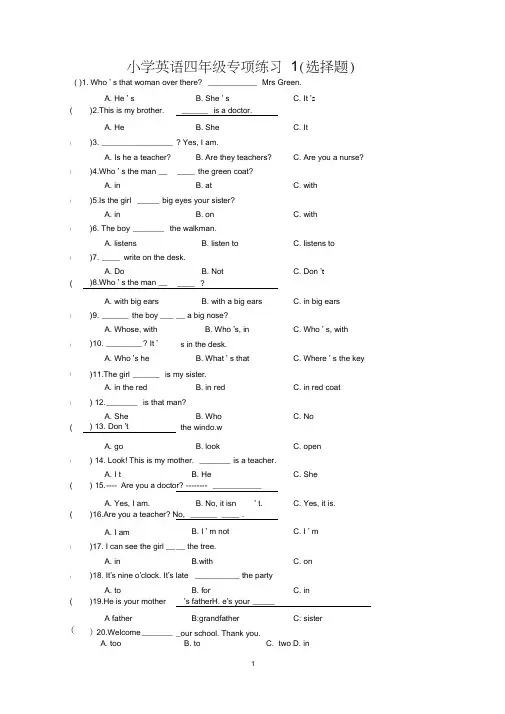
小学英语四年级专项练习1(选择题) ( )1. Who ' s that woman over there? ___________ Mrs Green.() 21. _______ Mr Black a teacher? No, ・ >isn' t.A. is, heB. its, HeC. Is, heD. It ' s, she () 22.Is that woman your mother? Which _______ one? ___ ____ one in the blue dressA. the, TheB. \, \C. \, TheD. the, \()23. _______ the girl _______ the red T-shirt.A. Who 's, inB. Whose, onC. Who 's, onD. Whose, in () 24.May I _______ your name? Sure. _______ name is Dick.A. no, MyB. know, MyC. no, ID. know, I() 25.Look, that is ___ ___ . It ' s four___now.A. a clock, o 'clockB. o ' clock, a clockC. o ' clock, o 'clockD. a clock, a clock()26.What are _____ ? They are pineapples.A. thisB. these C . it()27. ____ is her job?A. WhatB. WhichC. W ho( )28.They ' re my uncles. They 're _____ .A. pearsB. boys C . workers()29. ____ climb table again.A. NotB. Don ' tC. D o()30.Is this bus ___ the station? Yes .A . to B. for C. b y()31. _______ do you go to school? At 6;30.A. HowB. What timeC. W hat()32.Shall we go there_ _____ minibus? Great.A. on B . at C. b y()33.The coffee is ___ __ you . Thank youA. toB. forC. a bout()34. What are these ?_ ______ lemons.A. It ' sB. They ' reC. T here 're()35. __________ is the pie? ________ six yuan.A. How many , It ' sB. How much , They 'Cre. How much, It 's ( )36.She ' s my father ' s mother. Who ' s she?A. uncleB. motherC. grandmother( )37. —Can I help you ? — ______ some bananas,please.A. I want to beB. I ' d likeC. I like( )38.—How many _______ ? —One _________ , please.A. kilos/kiloB. kilo/kiloC. kilos/kilos( )39.—These or those ?—The big ______ ,please.A. onesB. itC. one( )40. —What are ______ jobs ? —They are _______ .A. they/farmersB. his/farmerC. their/farmers( )67. There ___________ a pencil and some books in the bag.A.isB. ' sC.are ( )68. There is a picture and a clock _______ the wall. A.on B.in C.at ()69. There is a basketball ______ the playground.A.onB.inC.at ( )70. — What _________in the classroom ? — There _______ some chairs. A.are/isB.is/areC.do/are( )71. There ___________some rice _______ the bowl.A.are/inB.is/onC.is/in( )72.Mr Green is my father ' s brother.He ' s my _____________A: brotherB: uncleC: aunt()73.---Excuse me . Is this minibus _______ the airport? ---Yes. Get on, please. (请上车吧 ) A: in B: on C: for()74. ---Can I help you?---Some _______ , please.A: strawberry B: strawberrys C: strawberries( )75. --- Mum, there ' s _____________ milk in the fridge.---Have some juice then.( )76.--- You ' re not fine. Come to me and I can help you. What---I think you are a _______ . A: teacher B: doctor C: policeman()77.---Can you use chopsticks, Nancy?---No, I can ' t. But I ' d like _____________ .A: to try B: try C: trying ( ____ )78.--- It ' s hot today, it? ---Yes. Let ' s go _________ .A: is …swimming B: isn ' t …swimminC : isn ' t …swim ( )79.--- What ' s in themusic room?A:There ' s a piano and some chairs. B: They ' re a pianaond some chairs.C: There are a piano and some chairs. () 80.Is she your teacher? ______________A. Yes, she ' s.B. Yes, she is. ( ) 81. bike is it ?( ) 82. Are you new doctors? Yes, ______________A. I amB. we areC. we ' reA.noB.onC./A: no B: not a C: anys my job?C. No, she is.C. WhoseA. Who ' sB. Who) 83. What' s the job ? She is a nurse.A. man ' sB. woman ' sC. her father 's) 84. Two kilos, please.A. How many kilo?B. How much kilos?C. How many kilos?) 85.What A. are, It these ? apples.'s B. is , It 's C. are, They 're86.e boy big nose is here.A. with … a new87.Is that old man JimA. he is88.I can see applesCan you see Liu TaoA. in … on89.B. wit h a … newC. with … newD./ … new s uncle? Yes,B. he isn ' tC. she isD. she isn ' t the tree.the tree.B. on … inC. on … onD. in …inthat girl? She' s Lily.daughter is she? She's Mr Li A. Whose ...Whose ' s.B. Who ' s … WhoseC. Who' s … Who' sD. Whose … Who' s90.he student the blue coat is son.A. on … he ' sB. in … hisC. in … heD. on …his 91.It ' s nine o' clock. It ' s late class.A. toB. forC. inD. on92.Lucy ,Helen and Mr Green in the cinema.A. isB./C. areD. isn93.Six and fifty is Fifty-five. , you reA. Yes … wrongB. Yes … right94.It' s sunny today, C. No…wrong D. wrong … rightit?They ' re good girls, they?A. isn ' t … isn ' tB. is … areC. isn ' t … aren 'D.tisn 't ..is95.Ben a new football. HeA. have … plays)96. dress is it?A. Whose)97.Are theyA. orange)98.How do we goA. park)99.Where is the fridge?A. Beside the door.)100.There someA. are book it at school.B. have … playC. has … playsD. have … plyaB. Who ' sB. an orangeB. thereB. Under the bed. in the bookcase.B. is bookC. WhatC. oranges C. to thereC. On the wall.C. are bookstwo (同音词)_________________look (同义词)_ is not (简略形式)my (对应词)picture (同义词)_ box (复数形式)_ like (同义词)____________it '(完全形式)_ I ' d like完全形式)isn '(完全形式)_ that s'(完全形式)_ no (反义词)____________ here (反义词)___I (宾格) ________ where is (简略形式)your (人称代词)_ her (人称代词)_Miss Li (所有格)do not (简略形式)go (反义词)________there (反义词)what' S 完整形式)good (反义词)know (同音词)thin (反义词)_ teachers (所有格)bus (复数形式),here '(s完全形式)is(复数)no(同音词)no(同义词)__my(人称代词)let '完整形式)—I'完整形式)—they(单数)_they '完整形式)______they '单数) _________ whose(同音词)_ _ pretty(近义词) after noon(对应词)_ _open(反义词)_ _ -that ' s all rig近义词组)I ' v完整形式)your(对应词)_ 64.our (单数) _______66.our(宾格)_____67. their(宾格)___68. there's伉整形式)69. bread 复数)__70. glass 复数)___71. new(对应词)_1.2.3.4.5.6.7.8.9.10.11.12.13.14.15.16.17.18.19.20.21.22.23.24.25.26.27.28.29.30.31.32.33.34.35.36.37.38.39.40.41.42.43.44.45.46.47.48.49.50.51.52. this (反义词)小学英语四年级专项练习2(词形转换)sit(反义词) ____ _dow n(反义词) _____sit down 反义词)_____hot(反义词)_____some单数)________glass同义词) _______four (同音词)_good (同义词)can't完全形式)boy (对应词)you(对应词)I (对应词)—small (对应词)long (对应词)short(对应词)53.54.55.56.57.58.59.60.61.Mum(对应词).65110.our(人称代词)72. stude nt 对应词)74. woman (复数)_75. m an (复数形式)76.our (人称代词)_77. our(单数)__ I78. our(对应词)__79. his(人称代词)—80. you ' re完整形式)81. r ight (同音词)_83. brother(对应词)84. white (反义词)_85. gra ndfather 对应词)86. waitress 对应词)87. waitress复数)_88. policema n(对应词)_89. policeman (复数)_90. their (同音词) _91. their(单数) ___92. their (人称代词)_94. some 单数)____95. peach 复数) ___97. ma ngo复数)_98. this(复数)____99. that(复数)_小学英语四年级专项练习3 (句型转换)1.1 ' m in the TV room改为否定句)I' m _________ i n the TV room.2. I like dolls.(改为否定句)I _______ like dolls.3. He ' s cold.改为否定句)He _____ cold.4. This is my fan.(改为一般疑问句)_______ you ________ a boy?7. She ' s a nice girl(改为一般疑问句)___________a nice girl ?8. They ' re his shoe(改为一般疑问句)______ ______ his shoes?9. Are you hot?(作肯定和否定回答)Yes, ___ _________ . No, ________ _________ .10. Can you see a purse?(作肯定和否定回答)Yes, _____ _______ . No, _______ _______11. Do you like dolls? (作肯定和否定回答)Yes, _____ _______ .No, _______ _________ .12. Is Mike ill? (作肯定和否定回答)Yes, _____ _______ . No, ________ _________ .13. Are they hun gry?(作肯定和否定回答)Yes, _____ _______ . No, _________ ________ .14. I ' d like a p对划线部分提问)______ would ________ like?15. I ' m cold对划线部分提问)______ the ______ ?16. I have lunch at 12:00.(对划线部分提问)_______ ______ do you _________________ ?17. Mr Green is in the study.(对划线部分提问)_______ Mr Green?18. It ' s 7:00)划线部分提问)_______ the_________ ?19. Nine and eight is seventeen.(对划线部分提问)________ nine and eight?20. Here are some fa ns for you.(改为单数句子)________ ______ _______ f or you.21. Open your books.(改为同义句)_________________ y our books.22.lt ' s time to go to scho改为同义句)It ' s time _______ school.23. One and two is three.(改为同义句)____________ two is three.24. Sit down.(改为否定句)__________________ _________ .小学英语四年级专项练习4 (特殊疑问句)对划线部分提问训练题的答题技巧1、划线部分是“事或物”,特殊疑问词用what如:This is a book.---What is this?I ofte n play football on Saturdays .---What do you ofte n do on Saturdays ?2、划线部分是“人”,特殊疑问词用who如:He is my brother. ---Who is he ?3、划线部分是“地点”,特殊疑问词用where 如:The box is on the desk.---Where is the box ?4、划线部分是“时间”,特殊疑问词用what time或when如:lt's seven twenty .——What time is it ?I usually get up at six . --- Whe n do you usually get up?5、划线部分是“年龄”,特殊疑问词用how old如:l am twelve . ---How old are you?My father is thirty-three . ---How old is your father ?6、划线部分是“职业”,特殊疑问词用what如:Mike is a worker. ---What is Mike ?7、划线部分是“颜色”,特殊疑问词用what colour如:My hat is blue . ---What colour is your hat?8、划线部分是“数量”,特殊疑问词用how many或how much 如:l can see five kites .---How many kites can you see ? There is some milk in the glass. ---How much milk is there in the glass ?9、划线部分是“多少钱”,特殊疑问词用how much如:This pen is nine yuan . ---How much is this pen ?10、划线部分是“形容词性物主代词或名词性物主代词”,特殊疑问词用whose 如:That is my book . ---Whose book is that ?The bag is yours. ---Whose is the bag ?练习:1. That car is yellow.(提示:问颜色)____ ____ is that car?2. My sister is 15 years old.提示:问年龄)3. The glasses are Jim s.(提示:问归属)____ glasses are these?4. Tom likes mon keys.提示:问”谁”)_____ _______ mon keys?5. I have eleven books in my bag.提示:问数量)_____ _______ books _______ ________ in your bag?6. I do my homework on Saturday.提示:问时间)______ d o you _______ your homework?7. She wants some eggs提示:问” 什么”)______ ________ she _______ ?8.1' m fine, thank you.(提示:问怎么样)______ are you?9. I go to school by bus.提示:问方式)______ do you go to school?10. We go to school five times a week.提示:问频率)______ _______ do you go to school?11. I ' mOiass 3.______ _______ are you in?12. The panda is black and white.____ ______ is the pan da?13. Her kite is under the bed.____ ______ her kite?14. I come to school by bike.____ _____ you come to school?15. Ben has a birthday prese nt.____ does Ben have?16. I can hear a bus.____ can you hear?17. Tony lives at 26 Lunwan Street.____ does Tony live?18. This is Ben ' s English book.____ English book is this?19. His father is an en gin eer.(对划线部分提问)______ h is father ' s __________ ?20. My first name is Tom.(改为同义句)My _______ _________ is Toms.按要求写句子1. in, what ' s, case, pencil,(o连词成句)2. Here' s a new tebook for you.(写出同意句)4. That is an umbrella on the chair.改为一般疑问句,)5. in, what, is, English, that (连词成句)6. It ' s a nice toy panda改写成感叹句)7. That' s my family photo on the desk.对划线部分提问)8. I ca n see eight mon keys in the trees 改疑问句,并作肯定回答)9. Is this a cat in En glsih?(否定回答)10. That is a copybook..改为一般疑问句,并作否定回答)11. the, get, eat, a, a, hamburger, girls, up, and, hot, and, dog连词成句)12. Do you like books?(作否定回答)13. I like this kite.(改为一般疑问句)14. this, in , what,E nglish, is (连词成句)15. like, much, that, very,doll,I (连词成句)16. I, for, my, some, juice, have, mum, may (连词成句)17. for, a, you, fan, is, here (连词成句)18. Liu Tao, where, Mike, are, and (连词成句)19. I like puzzles.(改为一般疑问句,并作肯定回答)20. This is a black cat.(对划线部分提问)21. That ' s Gao Shan ' s改为否定句)22. Here ' s a hamburger for y写出同意句)23. His copybook is in the schol bag.(对画线部分提问)24. this, bookmark, is, your (连词成句)25. This is Wang Bi ng -shirs. T(对划线部分提问)1126. Whose pen is it?(改为复数句子)27. That ' s John ' s sW写出te同意句)28. in, sit, come, and, down (连词成句)29. the, draw, on, don '(连词成句)30. Clean the bike, please.改为否定句)31.1 get up at six.(对画线部分提问)32.1 get up at six.(对画线部分提问)33」get up at six.(对画线部分提问)34. That' s a nice purs改为否定句)35. You cantopen the door .改为同义句)36. This storybook is for you.(写出同意句)37. This is Yang Ling 'bike.(对画线部分提问)38. The book is on the desk.(对画线部分提问)39. 是吃午饭的时间了。
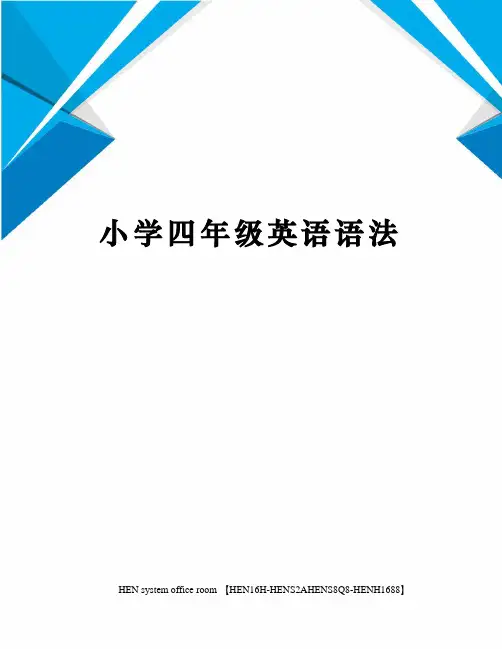
小学四年级英语语法 HEN system office room 【HEN16H-HENS2AHENS8Q8-HENH1688】小学四年级英语语法第一讲简缩形式的变法1、简缩形式的变法:把倒数第二个字母,通常是元音字母变成' 但are 除外,are 要把 a 打成' 。
Eg:he is=he's they are=they're2、简缩形式和完全形式的汉语意思相同。
3、把完全形式变成简缩形式时,一定要注意第一个字母的大小变化。
Eg:What is =What's4、记住一个特殊变化;let's =let us 让我们(不要把' 变成i )5、记住:this is 没有简缩形式 this's(错误)第二讲动词的用法1、到目前为止,我们学过的be 动词包括三个词 am ,is, are 这三个词的汉语意思相同,都是" 是" 的意思,但怎么运用好这三个词呢?请记住下列口决:2、我是 am eg:I am a pupil.3、你是 are eg:You are a girl.4、 Is 用在他、她、它 eg:He is a Chinese boy,She is an English teather,It is a cat.见到单数用is复数就用are.5、记住:am ,is 的复数是are.6、记住:these 这些;those 那些(这两个词都表示复数)第三讲一般疑问句1、一般疑问句最基本的变法:be(am,is,are)提前用问号读升调2、my 变成your our 变成yourI am / We are 变Are you I can 变Can you3、注意人名不论放在什么位置都要大写Tom is a student。
Is Tom a student?4、一般疑问句翻译成汉语都有" 吗" ?1)This is my English teather. Is this your English teather?第四讲就划线部分提问就划线部分提问的变法:1、先根据划线部分找到特殊疑问词。
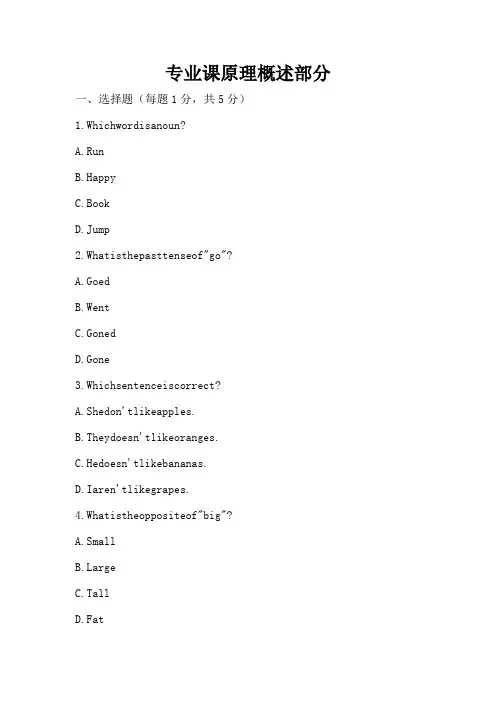
专业课原理概述部分一、选择题(每题1分,共5分)1.Whichwordisanoun?A.RunB.HappyC.BookD.Jump2.Whatisthepasttenseof"go"?A.GoedB.WentC.GonedD.Gone3.Whichsentenceiscorrect?A.Shedon'tlikeapples.B.Theydoesn'tlikeoranges.C.Hedoesn'tlikebananas.D.Iaren'tlikegrapes.4.Whatistheoppositeof"big"?A.SmallrgeC.TallD.Fat5.Whatisthepluralformof"child"?A.ChildsB.ChildesC.ChildrenD.Childs'二、判断题(每题1分,共5分)1."Run"isaverb.()2."Cat"isthepluralformof"cats".()3."Iam"isthesameas"I'm".()4."Hedidn'tgo"means"Hewent".()5."Shehas"isthesameas"Shehave".()三、填空题(每题1分,共5分)1.I_______(go)toschoolyesterday.2.She_______(like)playingbasketball.3.They_______(watch)amovielastnight.4.He_______(not/eat)breakfastthismorning.5.We_______(be)happytoseeyou.四、简答题(每题2分,共10分)1.Whatisanoun?2.Whatisthepasttenseof"eat"?3.Howdoyouformthepluralof"mouse"?4.Whatistheoppositeof"hot"?5.Writethecontractionfor"donot".五、应用题(每题2分,共10分)1.Makeasentencewith"run".2.Makeaquestionwith"where".3.Writeasentenceusing"Iam".4.Writeasentenceusing"theyare".5.Change"Ilikeapples"toaquestion.六、分析题(每题5分,共10分)1.Explnthedifferencebetween"Ilike"and"Idon'tlike".2.Explnthedifferencebetween"Shewent"and"Shegoes".七、实践操作题(每题5分,共10分)1.Readthefollowingsentenceandcorrectthemistakes:"Hedon'tlik eapplesandshedoesn'tlikeoranges."2.Writeashortstoryusingatleast5differentverbsinthepasttense .八、专业设计题(每题2分,共10分)1.设计一个简单的英语单词拼写游戏,要求包括至少5个单词。

小学英语语法专项练习题含答案(1)小学生语法专项练习题名词练习一 . 写出以下单数名词的复数形式答案 :1 oranges 2. Boxes 3. women 4. tomatoes 5.buses 6. boys7babies 8.watches 9. Photos 10 classes 11. feet 12 houses 13 pens 14 cars15 horses 16. radios 17 dishes 18 children二 . 将以下单词的复数形式改成单数形式1.doctors_________2.cities_______3.pianos__________4..ears________________ 10.knives__________11.men _________12.pears _________答案1. doctor 2 city 3 piano 4. ear 5. church 6. leaf 7 tooth 8zoo 9brush10 knife11.man 12 pear三 . 请从括号里选出正确的答案1.Please give me__(two /two cups of )coffee.2.There are a lot of___(sheep /sheeps ) on the farm.3.I ’d like some__ (bread / breads ) and___ (potato /potatoes).4.Look! There is a ___(mouse /mice) in the corner.5.He bought_____(a piece of /a piece ) paper.6.“Where is___ (Woman’s / Women’s) Room?” asked Susan.7.____ (The girl’s/The girls’ ) hobby is drawing.8.Aunt Lucy sent_____ (a child’s /a children ’ s ) book to me.红色为答案冠词练习1一 . 在空格内填上 a 或 anbook 14.______easy question 15.______orange dress16_______X-ray machine 17______ice cream答案1.16.an 17 an二 . 选择填空1.Mom tells her little daughter _____ old story every night. A. a B./ C. an D. the2. ______computer on the table is’s.Susan A. A B. An C. The D. /3.There is ______ map of the world on ______wall. ______map is mine.A. a, a, AB. a, the, TheC. the, the, TheD. the, the, A5.______Spring comes after______winter.A. /, /B.The, /C.The, theD.A, the6.I bought ______shoes yesterday. ______ shoes are very beautiful. A.a, The B. a pair of, The C. the, The D. a pair, The pair 7.He was ______soldier in the Second World War.A. aB. anC. theD. /8.She can play______ and ______.A. the tennis, the guitarB. tennis, guitarC. the tennis, guitarD. tennis, the guitar9.I can see______moon and ______clouds in the sky. A. the, a B. a, aC. the, /D. the, the11. ______Tian’anmen Square is in__Beijing. A. /, / B. A, / C. The, / D. /, the212. — Can you tell me ______nearest bookshop?— Go straight and turn right at_______third crossing, and youwill see it. A. the, a B. the, the C. a, the D. the, /红色为答案。
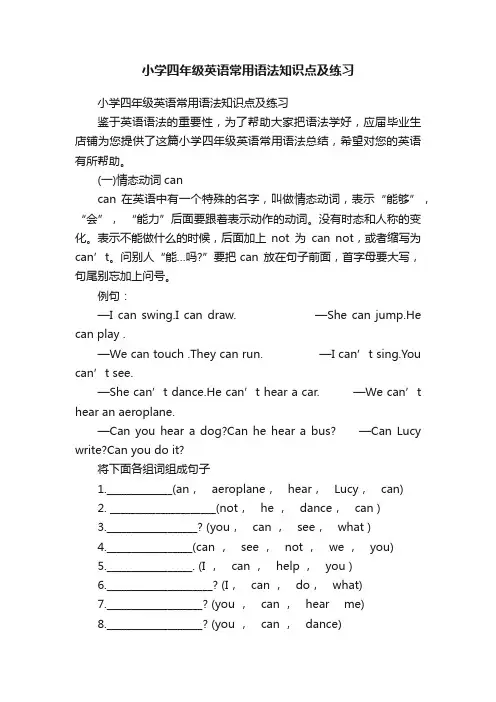
小学四年级英语常用语法知识点及练习小学四年级英语常用语法知识点及练习鉴于英语语法的重要性,为了帮助大家把语法学好,应届毕业生店铺为您提供了这篇小学四年级英语常用语法总结,希望对您的英语有所帮助。
(一)情态动词cancan 在英语中有一个特殊的名字,叫做情态动词,表示“能够”,“会”,“能力”后面要跟着表示动作的动词。
没有时态和人称的变化。
表示不能做什么的时候,后面加上not为can not,或者缩写为can’t。
问别人“能…吗?”要把can 放在句子前面,首字母要大写,句尾别忘加上问号。
例句:—I can swing.I can draw. —She can jump.He can play .—We can touch .They can run. —I can’t sing.You can’t see.—She can’t dance.He can’t hea r a car. —We can’t hear an aeroplane.—Can you hear a dog?Can he hear a bus? —Can Lucy write?Can you do it?将下面各组词组成句子1._____________(an,aeroplane,hear,Lucy,can)2. _____________________(not,he ,dance,can )3.__________________? (you,can ,see,what )4._________________(can ,see ,not ,we ,you)5._________________. (I ,can ,help ,you )6._____________________? (I,can ,do,what)7.___________________? (you ,can ,hear me)8.___________________? (you ,can ,dance)(二)人称代词所属格注意:主格作主语,其中she指带代国家,it可指代天气时间等。
一.用所给单词的适当形式填空1.Here________(be )policewomen.2.Look at the mouse?s ________(tooth).They?re sharp.3.Betty_______(like)monkeys and elephants.4.What ________your mother _______(do)?She?s___________(nurse).5.Here ____________(be)some bread for you.6.How many_____________(pony)are there on farm?7.Where is _____________(you)white rubber?8.My father can_____( swim)in the sea.9.He likes _____ (swim) very much.10.Mary _____ (have) _____ (a)orange dress.11.How old _____ (be)your sons?Theyre seven.12.____ (can) you count the books? No, I ____ (can).13.How many ____ (mouse)?There ____ (be) one mouse.14.Listen to ____ (I), please.15.____ (their)have some nice brushes.16.This is ____ (it) tall.17.What colour are the ____ (leaf)? They?re yelliw.18.What ___ (be)? You ____ (be) a manager.19.What do the _____ (lady)do ?They?re____( nurse )。
小学英语语法一本全第一章名词1.名词的数2.名词的格第二章代词1.人称代词2.物主代词第三章冠词与数词1.冠词2.数词第四章一般现在时态第五章现在进行时态第六章句型1.陈述句2.疑问句3.祈使句4.There be 句型与have\ has第七章总结考试名词的概念在生活中,我们会接触到各种各样的人和事物,用来表示这些人或事物名称的词就是名词。
一、名词的数名词的数指名词的单数和复数形式。
可数名词表示“一个”时用单数,“两个以上”时用复数;不可数名词表示量时,通常用“数词+单位+of+物质名词”的形式,如 a piece of bread (一片面包),变为复数时,只须将单位名词变为复数,如:two pieces of bread(两片面包)。
*名词复数的构成法则1. 一般情况下在词尾加 s. 词尾读音shop --- shops (商店) 在清辅音后读[ s ]bag --- bags (书包) 在浊辅音后读[ z ]window --- windows (窗户) 在元音后读[ z ]2. 以s, x, sh, ch 结尾的单词在词尾加es。
class --- classes (班级) 词尾读音[ iz ]box --- boxes (盒子)match --- matches (比赛)brush --- brushes (刷子)3. 以“辅音字母+y”结尾的词,变y为i 加es.story --- stories (故事) 词尾读音[ iz ]4. 以“元音字母+y”结尾的词,在词尾直接加skey --- keys 词尾读音[ z ]monkey --- monkeys5.以“o” 结尾的名词,复数一般在词尾加“s”, 但个别加“es”tomato --- tomatoes (西红柿) 词尾读音[ z ]potato --- potatoes (土豆)zoo --- zoos (动物园)photo --- photos (照片)*(以“o”结尾,复数加“es”)口诀:黑人(Negro)英雄(hero),左手拿着西红柿(tomato),右手拿着破土豆(potato),头顶一个大芒果(mango)。
小学英语语法练习题及答案小学英语语法练习题及答案【篇一:小学英语语法及练习题--名词】定义名词可以分为专有名词和普通名词,专有名词是某个(些)人,地方,机构等专有的名称,如beijing,china等。
普通名词是一类人或东西或是一个抽象概念的名词,如:book,sadness等。
普通名词又可分为下面四类:1)个体名词:表示某类人或东西中的个体,如:gun。
2)集体名词:表示若干个个体组成的集合体,如:family。
4)抽象名词:表示动作、状态、品质、感情等抽象概念,如:work。
个体名词和集体名词可以用数目来计算,称为可数名词,物质名词和抽象名词一般无法用数目计算,称为不可数名词。
2. 名词复数的规则变化(情况,构成方法,读音,例词)a. 一般情况在名词后加-s清辅音后读/s/map-maps浊辅音和元音后读 /z/bag-bags /car-carsb. 以s, sh, ch, x等结尾的名词加-es读 /iz/bus-buses/ watch-watches/brush-brushes/box-boxesc. 以ce, se, ze,等结尾加 -s读 /iz/license-licensesd. 以辅音字母+y结尾的名词把变y 为i再加es读 /z/baby---babiese. 以o 结尾的名词,变复数时:1). 加s,如: photo---photos piano---pianosradio---radioszoo---zoos;2). 加es,如:potato--potatoes tomato--tomatoes3). 上述a和b两种方法均可,如zero---zeros / zeroes。
f. 以f或fe 结尾的名词变复数时:1). 加s,如: belief---beliefsroof---roofssafe---safes gulf---gulfs2). 去f, fe 加ves,如:half---halvesknife---knives leaf---leaves wolf---wolveswife---wives life---lives thief---thieves3). 上述a和b两种方法均可,如handkerchief: handkerchiefs / handkerchieves。
四年级pep下册英语语法练习题在四年级的PEP英语教材中,语法点主要包括名词的单复数、动词的一般现在时和现在进行时、形容词的比较级和最高级、以及一些基本的句型结构。
以下是一些针对这些语法点的练习题,供同学们练习使用:1. 名词的单复数:- 请将下列单词的复数形式写出来:- book → ________- child → ________- box → ________- 选择正确的复数形式填空:- I have two ______ (apple/apples).- There are many ______ (mouse/mice) in the house.2. 动词的一般现在时:- 用括号中动词的正确形式填空:- She ______ (go) to school every day.- We usually ______ (watch) TV on weekends.3. 动词的现在进行时:- 用现在进行时填空:- Look! The birds ______ (fly) in the sky.- They ______ (play) soccer now.4. 形容词的比较级和最高级:- 将下列形容词变为比较级和最高级形式:- big → ______ (比较级) / ______ (最高级)- small → ______ (比较级) / ______ (最高级)- 用比较级或最高级填空:- This book is ______ (big) than that one.- She is the ______ (tall) girl in her class.5. 基本句型结构:- 用正确的疑问词填空:- ______ is your favorite color?- ______ do you usually go to school?- 回答下列问题:- What does your father do? (He is a teacher.)- Where are you going this weekend? (I am going to the park.)6. 综合练习:- 阅读下列句子,找出错误并改正:- The childrens are playing in the park. (改正:children → children)- She goes to the library every days. (改正:days → day) - 完成对话:- A: What are you doing?- B: I ______ (read) a book about animals.7. 翻译练习:- 将下列句子从中文翻译成英文:- 这是我最喜欢的书。
四年级上英语语法练习题英语语法是学习英语的基础,对于四年级的学生来说,掌握基本的语法规则非常重要。
以下是一些适合四年级上学期学生的英语语法练习题:1. 名词单复数练习:- 写出下列名词的复数形式。
- cat: ________- box: ________- leaf: ________- man: ________- foot: ________2. 动词的第三人称单数形式:- 将下列动词变为第三人称单数形式。
- eat: ________- have: ________- go: ________- watch: ________- do: ________3. 一般现在时态练习:- 用括号中动词的正确形式填空。
- She ________ (have) a big family.- He ________ (like) to play football.- They ________ (watch) TV every evening.4. 现在进行时态练习:- 用现在进行时态填空。
- Look! The birds ________ (fly) in the sky.- I ________ (read) a book now.- They ________ (play) games in the garden.5. 一般过去时态练习:- 用括号中动词的过去式填空。
- I ________ (go) to the park yesterday.- She ________ (see) a movie last night.- They ________ (have) a party last weekend.6. 形容词比较级和最高级练习:- 用比较级或最高级形式填空。
- This book is ________ (interesting) than that one. - He is the ________ (tall) in his class.- She runs ________ (fast) than her brother.7. 代词练习:- 用适当的代词填空。
小学英语语法及习题一、名词复数规则 1.一般情况下,直接加 -s ,如: book-books, bag-bags, cat-cats, bed-beds2.以 s. x. sh. ch 结尾,加 -es ,如: bus-buses, box-boxes, brush-brushes, watch-watches3.以 “辅音字母 +y ”结尾,变 y 为 i, 再加 -es ,如: family-families, strawberry-strawberries4.以 “f 或 fe ”结尾,变 f 或 fe 为 v, 再加 -es ,如: knife-knives 5.不规则名词复数:man-men,woman-women,policeman-policemen, policewoman-policewomen,mouse-micechild-children,foot-feet,. tooth-teethfish-fish,people-people, Chinese-Chinese, Japanese-Japanese 写出下列各词的复数 I _________him _________this ___________her ______ watch _______child _______photo ________diary ______ day________ foot________ book_______ dress ________ tooth_______ sheep ______box_______ strawberry _____ thief _______yo-yo ______ peach______ sandwich ______ man______ woman_______ paper_______ juice___________ water________ milk________ rice__________ tea__________The sky is blue.天空是蓝色的。
I get up at six every day 我.每天六点起床。
3.表示客观现实。
如: The earth goes around the sun 地.球绕着太阳转。
一般现在时的构成1. be 动词:主语 +be(am,is,are)+其它。
如: I am a boy.我是一个男孩。
2.行为动词:主语 +行为动词 (+其它 )。
如: We study English.我们学习英语。
当主语为第三人称单数 (he, she,it)时,要在动词后加 "-s" 或 "-es"。
如:Mary likes Chinese.玛丽喜欢汉语。
一般现在时的变化 1. be 动词的变化。
否定句:主语 + be + not +其它。
如: He is not a worker.他不是工人。
一般疑问句: Be +主语 +其它。
如: -Are you a student? -Yes. I am. / No, I'm not. 特殊疑问句:疑问词 +一般疑问句。
如: Where is my bike? 2.行为动词的变化。
否定句:主语 + don't( doesn't ) +动词原形 (+其它 )。
如: I don't like bread. 当主语为第三人称单数时,要用 doesn't 构成否定句。
如: He doesn't often play.一般疑问句: Do( Does ) +主语 +动词原形 +其它。
如: - Do you often play football? - Yes, I do. / No, I don't. 当主语为第三人称单数时,要用 does 构成一般疑问句。
如: - Does she go to work by bike? - Yes, she does. / No, she doesn't. 2.表示经常性或习惯性的动作。
如: 二、一般现在时 一般现在时基本用法介绍 【No. 1】一般现在时的功能 1.表示事物或人物的特征、状态。
如:特殊疑问句:疑问词 +一般疑问句。
如: How does your father go to work?动词 +s 的变化规则1.一般情况下,直接加 -s,如: cook-cooks, milk-milks2.以 s. x. sh. ch. o结尾,加 -es,如: guess-guesses, wash-washes, watch-watches, go-goes 3.以“辅音字母 +y”结尾,变 y 为 i, 再加 -es,如: study-studies一般现在时用法专练 :一、写出下列动词的第三人称单数drink ________ go _______ stay ________ make ________look _________ have_______ pass_______carry ____come________watch______ plant_______ fly ________study_______ brush________ do_________teach_______二、用括号内动词的适当形式填空。
1.He often ________(have) dinner at home.2.Daniel and Tommy _______(be) in Class One.3.We _______(not watch) TV on Monday.4.Nick _______(not go) to the zoo on Sunday.5.______ they ________(like) the World Cup?6.What _______they often _______(do) on Saturdays?7._______ your parents _______(read) newspapers every day?8.The girl _______(teach) us English on Sundays.9.She and I ________(take) a walk together every evening.10.There ________(be) some water in the bottle.11.Mike _______(like) cooking.12.They _______(have) the same hobby.13.My aunt _______(look) after her baby carefully.14.You always _______(do) your homework well.15. I _______(be) ill. I’ m staying in bed.16.She _______(go) to school from Monday to Friday.17.Liu Tao _______(do) not like PE.18.The child often _______(watch) TV in the evening.19.Su Hai and Su Yang _______(have) eight lessons this term.20.- What day _______(be) it today?-It ’s Saturday.三、按照要求改写句子1. Daniel watches TV every evening.改(为否定句 )___________________________________________________2.I do my homework every day.(改为一般疑问句,作否定回答 )________________________________________________________3.She likes milk.(改为一般疑问句,作肯定回答 )___________________________4.Amy likes playing computer games.(改为一般疑问句,作否定回答 )___________________________________________________5.We go to school every morning.改(为否定句 )_______________________________________________________6. He speaks English very well.(改为否定句 )___________________________________________________7.I like taking photos in the park.(对划线部分提问 )________________________________________________________8.John comes from Canada对.(划线部分提问 )___________________________________________________9. She is always a good student改.(为一般疑问句,作否定回答)________________________________________________________10.Simon and Daniel like going skating.(改为否定句 )___________________________________________________五、改错 (划出错误的地方,将正确的写在横线上 )1. Is your brother speak English? __________________2. Does he likes going fishing? __________________3. He likes play games after class. __________________4. Mr. Wu teachs us English. __________________5.She don ’ t do her homework on Sundays. _________________三、现在进行时1.现在进行时表示现在正在进行或发生的动作,也可表示当前一段时间内的活动或现阶段正在进行的动作。